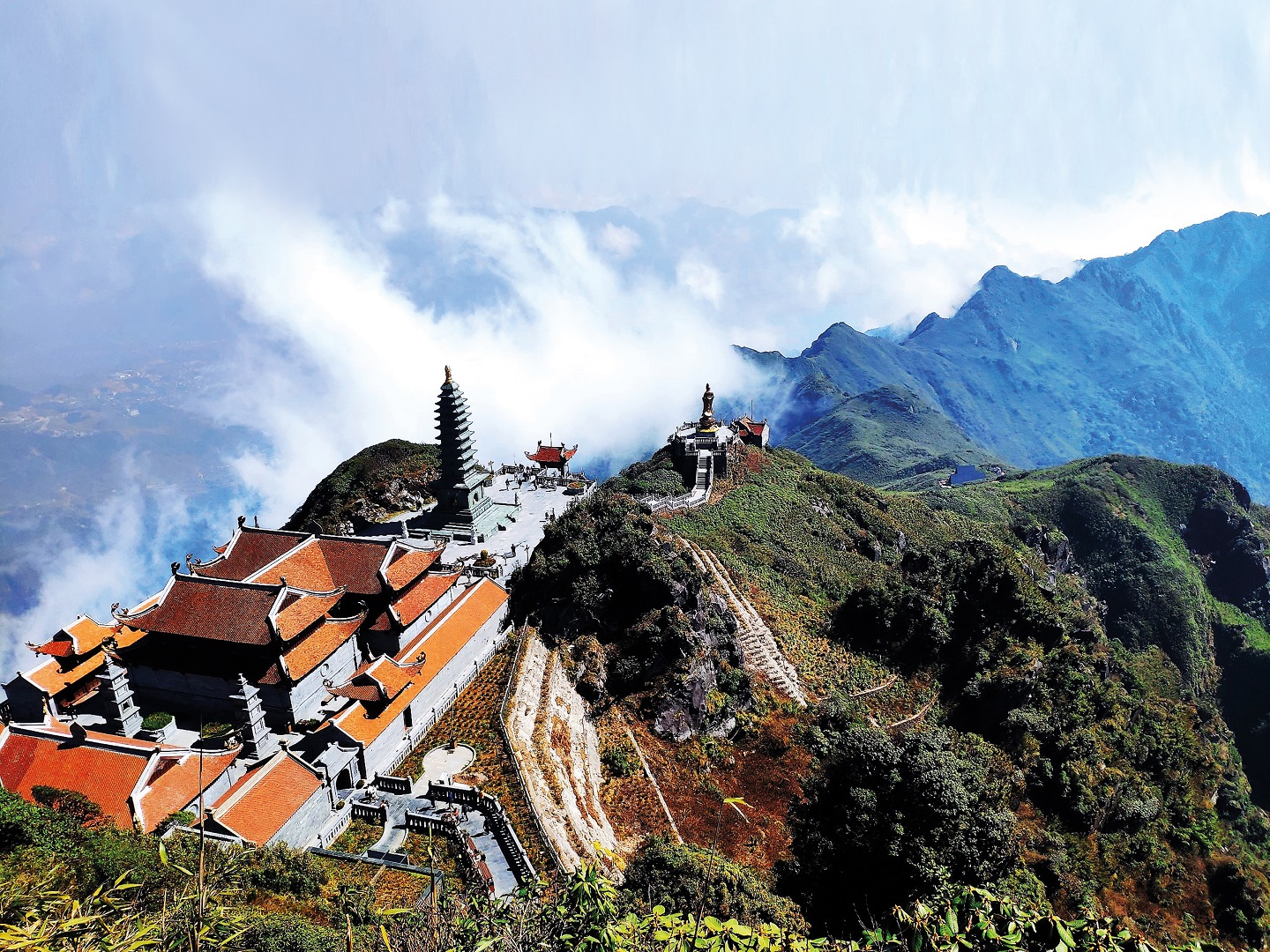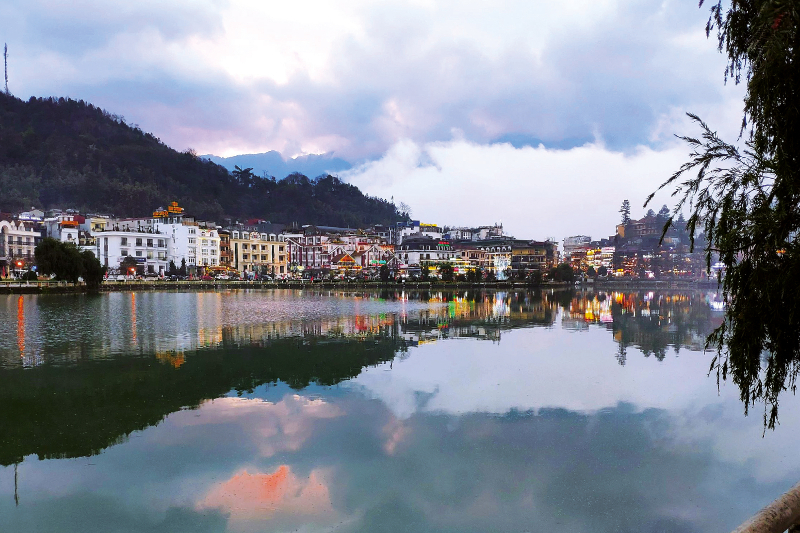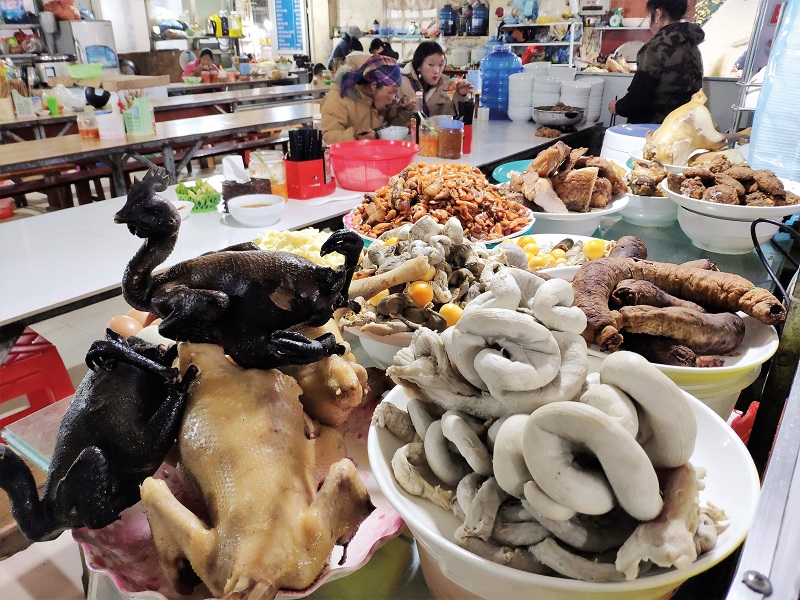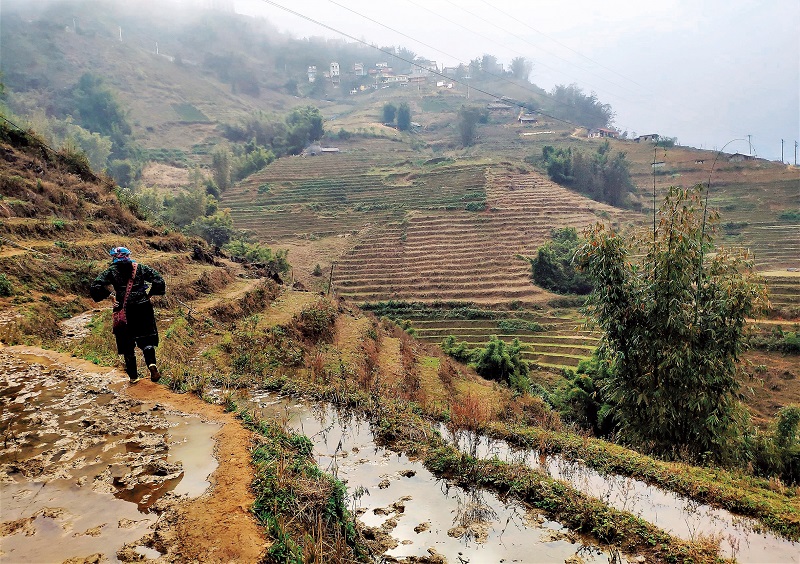
View of a pagoda and temple atop Fansipan. The statue of Avalokiteswara Bodhisattva stands at one end of the complex. (All photos: Lee Yu Kit)
From the airport, the shuttle van took me to the waiting room of the transport company to await the mother ship, which arrived 40 minutes later in a blaze of bright lights against the falling rain and dark skies over Hanoi.
The mothership was a large bus, converted to hold 20 sleeping berths on either side, leaving a narrow aisle. Each berth was a self-contained cubicle with a massage bed, pillow and blanket, full-length window with accordion blinds, USB charger, WiFi, bottled water, reading lights, TV screen and privacy curtain.
Before 2014, getting to Sapa from Hanoi involved an overnight train ride to the border town of Lao Cai, then a stomach-churning 40km journey up a winding mountain road by van or car. When I visited Sapa many years ago, the minivan had to stop to allow passengers to throw up.
In 2014, the Hanoi-Lao Cai highway changed all that, dramatically reducing travel time. Bus, minivan or car services became more viable options than the overnight train. Now, it takes just six hours to travel the 300 km from Hanoi to Sapa by road.
The widening of the twisting mountain road has improved accessibility and permitted large vehicles to drive right into Sapa, bringing inevitable development.
ho_lake.jpg

Change of scene
On this visit, Sapa came as something of a shock. In my memory, it was a mountain hamlet wreathed in mist, surrounded by forested hills, populated by tribespeople in colourful costumes, with backpacker accommodation and primitive roads. At night, the panorama of the night sky was lit up by the cold diamantine light of distant stars in a dark velvety sky.
But the Sapa of old is gone. Garish neon and fairy lights light up the buildings and obliterate the dark sky. The view is obscured by multi-storey buildings and construction cranes, and loud music from pubs and karaoke joints late into the night banish an early night’s sleep.
There is a large open town square with a blindingly bright giant LED screen, swanky shopping malls, trendy cafés, massage parlours, hotels, restaurants, souvenir shops, boutiques, travel agents and paved roads plied by motorcycles and cars. Shops try to outdo each other in the volume and variety of lights festooning their gaudy exteriors. Sapa has catapulted from being a quiet mountain hamlet to a boom town on steroids.
Development has brought economic gain, a tourist industry boasting well-heeled travellers and job opportunities. For the mountain tribes people who inhabit the surrounding villages, who were considered poor even by Vietnamese standards, the bright lights and influx of people has brought jobs, electricity to remote hamlets, paved roads, schools and ownership of things once unattainable — motorcycles, cars, TVs, washing machines, hot water on demand, and involuntary participation in the cash economy.
On clear days, the mist-wreathed, rugged mountain peaks surrounding the town evoke its ubiquitous cool environment (Sapa is 1,640m above sea level). One can see the tallest mountain in Vietnam, Fansipan, as well as the man-made structures on its summit.
market.jpg

Cool Fansipan
At 3,143m, Fansipan was a hiking destination that required a couple of hard days’ trek. That changed in 2016 with the opening of a cable car and funicular railway system that runs from the heart of Sapa to the summit.
The journey has three sections. Since 2018, a funicular railway from the incongruously European-styled Sun Plaza in the heart of Sapa takes 10 minutes to reach the cable car station at Muong Hoa, which is a destination in itself, with its mini commercial centre and extensive gardens.
Cable cars run from this station for about 15 minutes over a terraced valley and up the rugged, forested mountains of the Hoang Lien Son National Park to just a short distance below the summit of Fansipan, where another funicular railway takes you to your destination in a jiffy. Visitors can opt to take the 600-step ascent instead in the thin mountain air.
The cable car system is the world’s longest three-line at over 6.2km and has the highest altitude difference at 1.4km. Up to 35 people can be accommodated in each panoramic-windowed cable car. The system carries 2,000 persons per hour.
Despite the stiff ticket price, on weekends and busy days, it can take several hours to get to the top. Hundreds, if not thousands, undertake the journey daily, for the striking panoramas on clear days or the surreal experience of sinking into dense, white clouds in the uncanny silence of a cable car.
A massive “cultural spiritual” complex of stone terraces and staircases, with 15th to 16th-century-style Vietnamese pagodas, giant statues, viewing platforms and commercial facilities of shops, cafés and restaurants sprawl over the summit area. According to the information boards, the complex was built in 800 days and nights, involving 100,000 tonnes of Ninh Binh green stone and 2,000 cu m of ironwood.
The most impressive structure in the complex is the giant Amitabha Buddha statue, from which a 30m, nine-level artificial waterfall cascades. Inside the statue is a crystal pagoda in which a Buddhist relic sits.
On a nearby peak, a large statue of Avalokitesvara Bodhisattva — also known as Kwan Yin, the Goddess of Mercy — stands alone, holding a sprig and gazing serenely over the rugged mountain peaks.
The summit is indicated by a metal triangle, which is off limits to visitors. A couple of “false” metal summit triangles stand nearby for Instagrammers. Some country flags have even been thoughtfully provided so visitors can wave their flag beside a metal marker on which the word “Fansipan” is prominently displayed.
Nearby, on a viewing platform, a giant Vietnamese flag flutters on a tall flagpole. To one side, one can see Sapa town on a clear day. On the other sides rise rugged forested ranges. This is the Hoang Lien Son National Park, a high-altitude area of great biodiversity covering 264 sq km.
fields.jpg

Ascending order
From the cable car, the tediously terraced paddy fields on the hillsides can be seen. They provide livelihood for the mountain tribes who have lived in this region for hundreds of years.
At ground level, the enormity of the labour of the rice terraces becomes evident. Rice is planted and harvested once a year. Fields are irrigated, even those high on hills slopes far removed from water sources. Over hundreds of years, densely forested mountainous slopes have been cleared and terraced with remarkable precision — an astonishing feat of engineering and backbreaking labour — with only simple hand tools.
The most numerous of the tribes around Sapa are the Black Hmong, distinguished by the women’s distinctive costumes made with hemp cloth woven from the bark of marijuana plant saplings and dyed black from the extract of leaves of the indigo plant.
My hiking guide, a sandal-clad woman called Xing from the Black Hmong tribe, collected me from the hotel and we descended tiered rice fields to her home village and a spot of lunch. She spoke excellent English, with good enunciation, but could neither read nor write, having picked up the language solely from contact with tourists.
In her mid-thirties, Xing has seen more changes in her lifestyle than her ancestors had in the past few hundred years. Previous generations were subsistence farmers, growing and harvesting rice, eking out a precarious livelihood from the hilly slopes of the mountains in the cool, lush climate, largely isolated from society.
Sapa opened to tourism in the last quarter of the 20th century, and with tourism came rapid development and opportunities for income beyond growing rice.
I had hiked the same terrain many years ago, and the changes were marked: paved roads in place of muddy walking paths, sturdy buildings made of industrial materials instead of simple huts, a steady electricity supply offering conveniences and comforts.
In just a few short years, Sapa has transformed beyond recognition. What would it, and the lifestyle of the mountain tribes, be like a few years from now, I wonder.
This article first appeared on May 15, 2023 in The Edge Malaysia.


